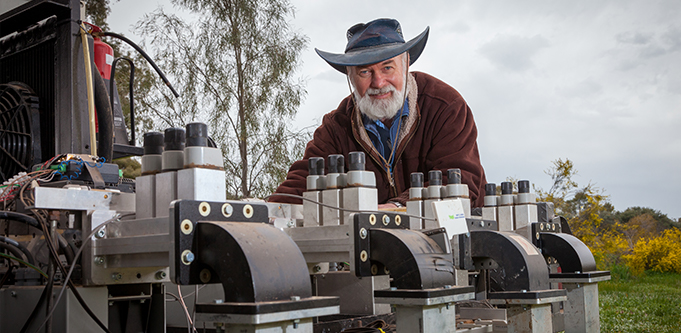
Growave founder and inventor Graham Brodie. Source: supplied.
Agtech startup Growave has secured $900,000 in seed investment to commercialise its weed-killing microwave technology.
Founder Graham Brodie tells StartupSmart the breakthrough technology is over a decade in the making.
Grown out of research labs at the University of Melbourne, it took some time to kick off the funding process.
Now, investors IP Group, Grain Innovate and Artesian project it will be ready for international markets in the next 18 months.
The growing need for agtech
Weed management costs the Australian agricultural scene an estimated $2.5 billion every year.
Part of the cost is developing various control methods to tackle resilient weeds. In Australia alone, there are at least 25 different species of weeds resistant to traditional herbicides.
Globally, weeds are becoming increasingly resistant to glyphosate, the primary ingredient in well-known herbicides such as Monsanto’s Roundup.
After hearing about the increasing prevalence of pesticide-resilient weeds, Brodie used his background in microwave communication and energy transfer to create a sustainable alternative to chemical treatments.
“Whenever you put anything that has a lot of water in a microwave oven, it starts to heat up. We can do the same thing by projecting energy onto the ground,” he explains.
“Basically, what it does is, if it’s an emerged weed, it creates little explosions inside the plant and that, of course, kills the plant.
“If the seed is in the soil, what it does is it actually heats the soil and the seeds up to the point where the seeds actually die and they won’t germinate or emerge.”
Growave’s capability to kill seeds without disturbing the soil also means it reduces airborne pathogens.
Also, while Brodie says the cost of microwave application will — in its current state — be on par with other soil treatments, microwave technology is also not weather dependent and can be deployed in strong winds or rain, and only to targeted areas.
“It’s actually quite specific,” Brodie says.
“Whatever you shine the microwave onto is what’s affected. It will kill anything the energy is exposed to, but it has quite a sharp treatment edge.
“There are examples that I’ve done where we’ve actually been able to treat plants on one side of a straight line and on the other side, the plants are unaffected.”
Seeding the venture
As part of the research and development phase, Brodie kept in contact with local and international farmers and was aware this technology would be commercially viable.
“Farmers are very aware of this issue and they are actively looking for alternatives,” Brodie says.
“Herbicide resistance was always an issue.”
Despite the demand, he says it took time to develop interest from investors.
The biggest roadblock Brodie came across was the need for a working scale model to secure funding from the industry, which is challenging for the manufacturing capacities of universities.
Intellectual property commercialisation company IP Group came on board as a major investor over 12 months ago to collaborate with the existing team to further develop an investment case.
IP Group’s head of physical sciences, and now Growave’s director, Paul Barrett, tells StartupSmart the decision came once IP Group could see Growave fulfilled its standard investment criteria.
“Typically, you’re looking at the technology, the market and the team as part of the market criteria,” he says.
In terms of market opportunity, IP Group didn’t just consider the farming industry’s need for alternative weed management, but also consumer concerns.
“Broadly, consumers are becoming more aware of chemicals in the food chain, whether that be plastics getting into the waterways or chemicals in our foodstuffs,” he says.
“With that backdrop, we were hungry to find an opportunity there to meet consumer demands.”
With $900,000 in seed funding to spend, Growave now plans to fine-tune its applicators on working crop farms across Australia.
It is also on track to release a commercial product in the next 18 months, but Brodie says getting it to this point took five years.
From ideation to sourcing investors, he encourages other tech developers to be patient and persevere.
“Both are essential elements nowadays to transfer ideas into reality.”
READ MORE: Farming must change its image and embrace technology, city life and millennials


COMMENTS
SmartCompany is committed to hosting lively discussions. Help us keep the conversation useful, interesting and welcoming. We aim to publish comments quickly in the interest of promoting robust conversation, but we’re a small team and we deploy filters to protect against legal risk. Occasionally your comment may be held up while it is being reviewed, but we’re working as fast as we can to keep the conversation rolling.
The SmartCompany comment section is members-only content. Please subscribe to leave a comment.
The SmartCompany comment section is members-only content. Please login to leave a comment.